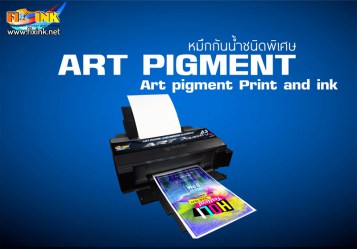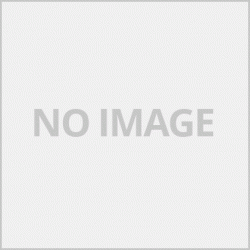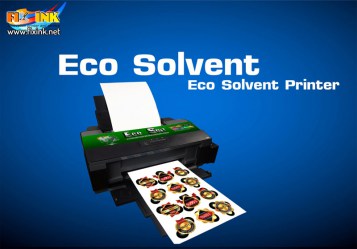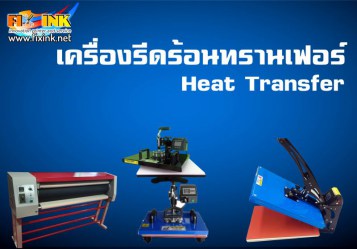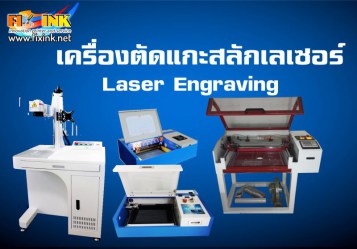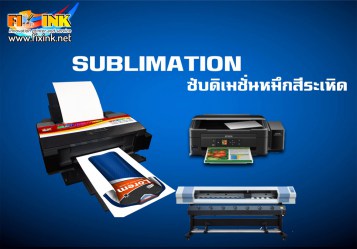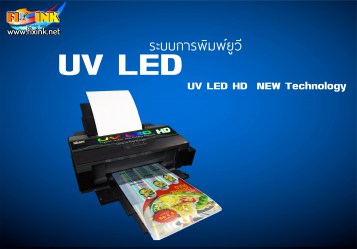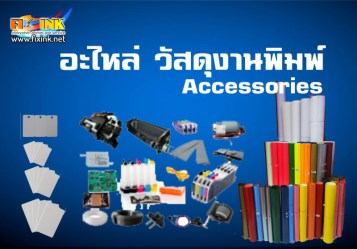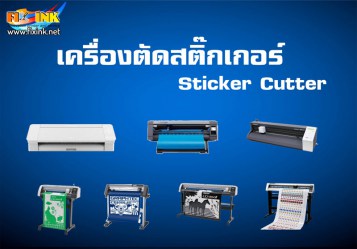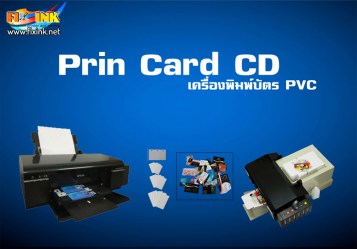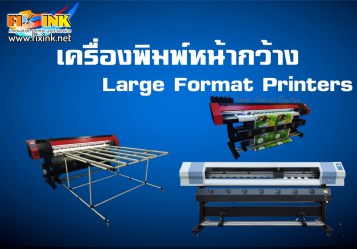ประเภทของการพิมพ์
ประเภทของการพิมพ์ที่แบ่งตามลักษณะของการพิมพ์สามารถจัดได้เป็นดังนี้
การพิมพ์พื้นนูน (Relief Printing) เป็นการพิมพ์ที่ใช้หลักการให้ส่วนที่เป็นภาพบนแม่พิมพ์จะมีผิวนูนกว่าส่วนอื่น เพื่อรับหมึกแล้วถ่ายลงบนวัสดุใช้พิมพ์ การพิมพ์ประเภทนี้มี การพิมพ์เลตเตอร์เพรสส์ การพิมพ์เฟล็กโซกราฟี
การพิมพ์พื้นลึก (Recess Printing) เป็นการพิมพ์ที่ใช้หลักการให้ส่วนที่เป็นภาพบนแม่พิมพ์จะมีผิวลึกกว่าส่วนอื่น เพื่อขังหมึกไว้แล้วถ่ายลงบนวัสดุใช้พิมพ์ การพิมพ์ประเภทนี้มี การพิมพ์กราวัวร์ การพิมพ์แพด
การพิมพ์พื้นราบ (Planographic Printing) เป็นการพิมพ์ที่ใช้หลักการน้ำกับน้ำมันไม่รวมตัวกัน ผิวของแม่พิมพ์ชนิดนี้จะเสมอกันหมดโดยให้ส่วนที่เป็นภาพมีสภาพเป็นไขมันสามารถรับหมึกซึ่งเป็นน้ำมันเช่นกัน ส่วนที่ไม่เป็นภาพจะสามารถรับน้ำไว้ได้ ในการพิมพ์ จะคลึงแม่พิมพ์ด้วยเยื่อน้ำ เยื่อน้ำไม่ถูกกับไขจะไปเกาะเฉพาะส่วนที่ไร้ภาพ แล้วคลึงหมึกตาม หมึกไม่ถูกกับน้ำจะไปเกาะเฉพาะส่วนที่เป็นภาพ เมื่อนำวัสดุใช้พิมพ์ทาบบนแม่พิมพ์ก็จะเกิดภาพตามต้องการ การพิมพ์ประเภทนี้มี การพิมพ์หิน การพิมพ์ออฟเซ็ท
การพิมพ์พื้นฉลุ เป็นการพิมพ์ที่ใช้หลักการให้หมึกผ่านทะลุส่วนที่เป็นภาพบนแม่พิมพ์ไปติดอยู่บนวัสดุใช้พิมพ์ ทำให้เกิดภาพ การพิมพ์ประเภทนี้มี การพิมพ์โรเนียว การพิมพ์ซิลค์สกรีน
การพิมพ์ดิจิตอล (Digital Printing) เป็นการพิมพ์ที่ใช้เครื่องพิมพ์ต่อพ่วงกับคอมพิวเตอร์ โดยรับข้อมูลภาพจากคอมพิวเตอร์มาพิมพ์
การพิมพ์แบบถ่ายโอนความร้อน (Thermal Transfer Printing) ซึ่งใช้หลักการถ่ายความร้อนจากหัวพิมพ์ไปยังฟิล์มที่เคลือบด้วยหมึกพิมพ์ทำให้หมึกพิมพ์หลุดไปเกาะติดกับวัสดุใช้พิมพ์จนเกิดเป็นภาพ
การพิมพ์แบบพ่นหมึก/อิงค์เจ็ท (InkJet Printing) ซึ่งใช้หลักการพ่นหยดหมึกเล็ก ๆ จากหัวพ่นไปสร้างเป็นภาพบนวัสดุใช้พิมพ์
การพิมพ์แบบไฟฟ้าสถิตย์ (Electrostatic Printing) ซึ่งใช้หลักการควบคุมลำแสงสร้างภาพเป็นประจุไฟฟ้าบนกระบอกโลหะแล้วให้ผงหมึกไปเกาะบนกระบอกโลหะตามบริเวณที่มีประจุอยู่เกิดเป็นภาพที่ถูกถ่ายทอดไปเกาะติดบนวัสดุใช้พิมพ์อีกทีหนึ่ง
ประเภทของการพิมพ์ที่ผู้ประกอบการโรงพิมพ์นิยมทำกันในปัจจุบันมีดังนี้
การพิมพ์ออฟเซ็ท (Offset Printing) เป็นการพิมพ์พื้นราบที่ใช้หลักการน้ำกับน้ำมันไม่รวมตัวกัน โดยสร้างเยื่อน้ำไปเกาะอยู่บนบริเวณไร้ภาพของแผ่นแม่พิมพ์ เมื่อรับหมึก หมึกจะไม่เกาะน้ำแต่จะไปเกาะบริเวณที่เป็นภาพแล้วถูกถ่ายลงบนผ้ายางและกระดาษพิมพ์ต่อไป การพิมพ์ออฟเซ็ทสามารถผลิตงานพิมพ์ที่มีคุณภาพสูงจนถึงสูงมาก เครื่องพิมพ์มีหลายขนาด มีทั้งเครื่องพิมพ์ 1 สี 2 สี 4 สี 5 สี หรือมากกว่านั้น ตัวอย่างงานพิมพ์ออฟเซ็ท เช่น พิมพ์แผ่นพับ พิมพ์ใบปลิว พิมพ์หนังสือ พิมพ์วารสาร พิมพ์นิตยสาร พิมพ์โบรชัวร์ พิมพ์แคตตาล็อก บรรจุภัณฑ์กระดาษ งานพิมพ์ใช้ในสำนักงาน ฯลฯ
การพิมพ์เลตเตอร์เพรสส์ (Letterpress Printing) เป็นการพิมพ์พื้นนูนที่ใช้แม่พิมพ์ทำจากโลหะผสมหรือพอลิเมอร์อย่างหนากัดผิวจนเหลือส่วนที่เป็นภาพนูนสำหรับรับหมึกพิมพ์แล้วถ่ายทอดลงบนวัสดุที่ใช้พิมพ์โดยใช้วิธีกดทับ ในยุคก่อนมีการใช้ตัวอักษรโลหะเป็นตัว ๆ มาจัดเรียงเป็นข้อความที่ต้องการแล้วใช้เป็นแม่พิมพ์ การพิมพ์เลตเตอร์เพรสส์มีมาช้านานเก่าแก่มาก ในปัจจุบันมีการพิมพ์ประเภทนี้เหลืออยู่น้อย เนื่องจากการทำแม่พิมพ์ลำบากและภาพพิมพ์ที่ได้ไม่ค่อยสวยงาม ตัวอย่างงานพิมพ์ประเภทนี้คือ นามบัตร แบบฟอร์ม ฉลาก กล่อง ป้ายและงานพิมพ์อื่น ๆ ที่ไม่ต้องการความละเอียดมาก
การพิมพ์(ซิลค์)สกรีน (Silkscreen Printing) เป็นการพิมพ์พื้นฉลุที่ใช้หลักการพิมพ์โดยให้หมึกซึมทะลุผ่านผ้าที่ขึงตึงไว้ และให้ทะลุผ่านเฉพาะบริเวณที่เป็นภาพ สามารถพิมพ์งานสอดสีได้ ความละเอียดของภาพพิมพ์ขึ้นอยู่กับความถี่ของเส้นใยผ้า สามารถพิมพ์ลงบนวัสดุได้หลากหลากชนิด ทั้งกระดาษ ผ้า ไม้ พลาสติก และพิมพ์บนวัสดุที่มีผิวโค้งได้ ตัวอย่างงานพิมพ์ประเภทนี้คือ นามบัตร บรรจุภัณฑ์ต่าง ๆ ป้ายกระดาษ/พลาสติก/โลหะ ป้ายโฆษณา เสื้อ ผืนผ้า ถุงพลาสติก ขวด จานชาม ชิ้นส่วนอุปกรณ์ต่าง ๆ
การพิมพ์ดิจิตอล (Digital Printing) เป็นการพิมพ์ที่ใช้เครื่องพิมพ์หรือพริ้นเตอร์ต่อพ่วงกับเครื่องคอมพิวเตอร์ สามารถสั่งพิมพ์ได้โดยตรงจากเครื่องคอมพิวเตอร์ เครื่องพิมพ์หรือพริ้นเตอร์ที่ใช้คือ เครื่องพิมพ์อิ้งค์เจ็ทขนาดเล็กและใหญ่ เครื่องพิมพ์เลเซอร์ความเร็วปกติจนถึงความเร็วสูงเครื่องพิมพ์ดิจิตอลใช้หมึกประจุไฟฟ้า ตัวอย่างงานพิมพ์ประเภทนี้คือ งานพิมพ์ที่มีปริมาณไม่มาก เช่น นามบัตร แผ่นพับ ใบปลิว หนังสือ งานพิมพ์ที่มีการเปลี่ยนภาพหรือข้อความบ่อย ๆ เช่น ไดเร็คเมล์ งานพิมพ์ป้ายโฆษณาขนาดใหญ่ (ใช้เครื่องอิ้งค์เจ็ทขนาดใหญ่)
การพิมพ์เฟล็กโซกราฟี (Flexography) เป็นการพิมพ์พื้นนูนที่ใช้แผ่นพอลิเมอร์ที่มีความยืดหยุ่นที่ดีเป็นแม่พิมพ์โดยกัดส่วนที่ไม่รับหมึกเว้าลึกลงไป การพิมพ์ในระบบนี้ใช้หลักการคล้ายกับการพิมพ์แบบเลตเตอร์เพรสคือใช้การกดทับ แต่หมึกที่ใช้จะเหลวกว่าและใช้ลูกกลิ้งที่ทำขึ้นเป็นพิเศษทำหน้าที่จ่ายหมึกในปริมาณที่สม่ำเสมอให้กับแม่พิมพ์ การพิมพ์ประเภทนี้ได้รับการพัฒนาจนสามารถพิมพ์ภาพสอดสีได้ แม้คุณภาพงานพิมพ์จะยังเทียบเท่าการพิมพ์แบบออฟเซ็ทไม่ได้ แต่ก็มีใช้ในสิ่งพิมพ์หลาย ๆ ประเภท งานพิมพ์ประเภทนี้คือ กล่องลูกฟูก กล่องกระดาษแข็ง ฉลาก ป้าย กล่องกระดาษ กระดาษชำระ ถุงและซองพลาสติก และงานพิมพ์สอดสี
การพิมพ์กราวัวร์ (Gravure) เป็นการพิมพ์พื้นลึกที่ใช้แม่พิมพ์ที่เป็นร่องลึกสำหรับบริเวณที่เป็นภาพเพื่อเก็บหมึกแล้วไว้ปล่อยลงบนผิวของชิ้นงานพิมพ์ คุณภาพของงานพิมพ์ประเภทนี้อยู่ในเกณฑ์ที่ดี แม่พิมพ์แบบนี้มักเป็นลูกกลิ้งทรงกระบอก ทำด้วยโลหะใช้วิธีกัดผิวทรงกระบอกเป็นหลุมตามบริเวณที่เป็นภาพ จึงทำยากและใช้เวลา อีกทั้งมีค่าใช้จ่ายสูง จึงเหมาะกับงานยาว ๆ งานพิมพ์ประเภทนี้คือ งานพิมพ์ประเภทซองพลาสติกใส่อาหารและขนม และงานพิมพ์บนพลาสติกต่าง ๆ งานพิมพ์ในต่างประเทศบางแห่งมีการพิมพ์แมกกาซีน หนังสือพิมพ์ และงานพิมพ์บนกระดาษที่มีปริมาณพิมพ์สูง
การพิมพ์ประเภทอื่น ๆ นอกจากการพิมพ์ประเภทต่าง ๆ ที่กล่าวมาแล้วนี้ ยังมีการพิมพ์ที่มีลักษณะการพิมพ์แบบอื่น ๆ เช่น การพิมพ์โรเนียว หรือ การพิมพ์สเตนซิล เป็นการพิมพ์พื้นฉลุซึ่งใช้กระดาษไขเป็นแม่พิมพ์ให้หมึกตรงบริเวณที่เป็นภาพสามารถซึมทะลุมายังแผ่นกระดาษที่ต้องการพิมพ์ การพิมพ์แพด เป็นการพิมพ์พื้นลึกซึ่งใช้ยางนิ่มรับหมึกที่เป็นภาพจากแม่พิมพ์ แล้วกดทับบนชิ้นงานซึ่งมีพื้นผิวรูปทรงต่าง ๆ
งานพิมพ์ส่วนใหญ่ในท้องตลาดเป็นงานพิมพ์ประเภทออฟเซ็ท เนื่องจากมีความสะดวกและคล่องตัวในการผลิต ดังนั้นประเภทของโรงพิมพ์ที่มีให้บริการมากที่สุดก็คือโรงพิมพ์ออฟเซ็ท เช่นเดียวกับโรงพิมพ์สุพรีมพริ้นท์ ซึ่งนอกจากนี้เราพิมพ์งานประเภทออฟเซ็ทแล้ว เรายังให้บริการงานพิมพ์ดิจิตอลด้วย
ขอบคุณข้อมูลจาก http://www.supremeprint.net/ สุพรีมพริ้นท์ จำกัด
Type of printing
The types of printing that are classified according to the type of printing can be categorized as follows.
Relief Printing is a print that uses the principle that the image on the mold will be embossed than other parts. To receive ink and transfer it onto the substrate. This type of printing has Letterpress printing Flexographic printing
Printing depth (Recess Printing) is a print that uses the principle that the image on the mold will have a deeper surface than other parts. This will lock the ink and transfer it onto the substrate. This type of printing has Gravure printing, pad printing
Flatbed printing (Planographic Printing) is printing that uses the principle of water and oil, not combining. The surface of this type of mold is even, so the image part is fat. It can also accept oily ink. The non-visual part will be able to hold the water in the printing, it will roll the mold with water pulp. The membrane of the water is not attached to the wax, it will adhere to only the empty part. Then roll the ink accordingly The ink is not right with water, it will stick to only the picture part. When the print material is placed on the mold, the desired image will be produced. This type of printing has lithography, offset printing.
Openwork floor printing This type of printing uses the principle that the ink passes through the image on the mold and is attached to the substrate resulting in the image of this type of printing. Duplication printing Silkscreen printing
Digital printing (Digital Printing) is printing using a printer connected to a computer. By receiving image data from the computer to print
Thermal Transfer Printing, which uses the principle of transferring heat from the print head to a film coated with ink, causing the ink to adhere to the substrate, resulting in an image.
InkJet Printing, which uses the principle of spraying tiny droplets of ink from the nozzle to create an image on the substrate.
Electrostatic printing (Electrostatic Printing), which uses the principle of controlling the beam to generate an electric charge on the metal cylinder and then the toner to adhere to the metal cylinder along the charged area, resulting in the image being transmitted to the substrate
The types of printing that printing companies do today are as follows.
Offset Printing is a flat surface printing that uses the principle of water and oil, not combining. By creating a water pulp to stick on the blank area of the gravure when receiving ink, the ink will not stick to the water but will stick to the image area and will be transferred onto the rubber fabric and printing paper Offset printing can produce prints of high to very high quality. Printers come in different sizes. Both 1-color, 2-color, 4-color, 5-color or more printers are available. Examples of offset printing such as brochure printing, flyers printing, book printing, periodical printing, magazine printing, brochures printing Print catalog Paper packaging Printing work, office use, etc.
Letterpress Printing is an embossed print using a die made of a metal alloy or a thick polymer, etching the surface until a relief is left for receiving ink and transfer it onto the printed material. Using the pressing method In the old days, metal letters were used to arrange the desired text and use it as a mold. Letterpress printing has been around for a long time. At present there is little of this type of print. Due to difficult mold making and poorly printed pictures Examples of this type of print are business cards, forms, labels, boxes, tags, and other fine print.
Printing (Silkscreen Printing) is a stencil print that uses the principle of printing by allowing the ink to penetrate through the stretched fabric. And to pass through only the image area Can print color insert job The resolution of the print image depends on the frequency of the fabric. Able to print on a wide variety of materials including paper, fabric, wood, plastic and print on curved surface materials. Examples of this type of print are business cards, packaging, paper / plastic / metal labels, advertising signs, clothing, plastic bags, bottles, plates, and accessories.
Digital printing (Digital Printing) is printing using a printer or printer attached to a computer. You can print directly from your computer. The printer or printer used is Small and large inkjet printers Laser printers from normal to high speed Digital printers use electrically charged ink. Examples of this type of print are Small print jobs such as business cards, brochures, flyers, books, print with frequent image changes or text such as direct mail, large billboard printing (Using a large ink jet)
Flexographic printing (Flexography) is a type of convex floor printing using a good flexible polymer sheet by etching the part that does not accept ink deeply. Printing in this system uses a principle similar to letterpress printing, that is, press. Instead, the ink used is more fluid and a specially made roller is used to deliver the same amount of ink to the mold. This type of printing has been developed so that it can print color-coded images. Although the print quality is still not equivalent to offset printing. But they are also used in many publications.These types of prints are corrugated boxes, cardboard boxes, labels, labels, cartons, toilet paper, bags and plastic envelopes. And print with color
Gravure printing is a deep gravure printing that uses a deep groove mold for the image area to hold the ink and then release it onto the surface of the print. The quality of this type of print is good. This type of mold is usually a cylindrical roller. Made of metal, the cylindrical surface is etched into holes in the image area. So it is difficult and time consuming. It also has a high cost. Therefore suitable for long work, this type of printing is Type




